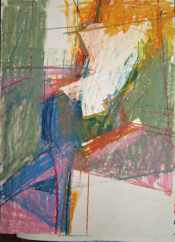Joyce Sampson
by Robert Sievert

Joyce Sampson:Untitled

Joyce Sampson died last summer. She was 76 and still struggling with the creative process, even during her final illness. She had been an artist most of her adult life and passed through periods of enormous creativity as well as empty stretches where little work was produced.
I first met Joyce in 1958 when she was a third year student in Cooper Union's evening art program. I was a first year student and we met as a result of our involvement with Nick Carone, our teacher and noted painter. Joyce organized Carone's private classes outside of school. That first summer we sublet Jack Tworkov's studio on the Bowery.
Everybody thought Joyce was special. She had talent and was open to new ideas. The late 50's was a very exciting time in the New York art world. Abstract painting had established itself as the dominant style and for the most part was what was shown. A lot of time was spent coursing from gallery to gallery looking at work. There was an excitement about painting.
Nick Carone's classes opened us up to the rationale of abstract painting. An understanding of abstract space and movement became available through Carone's teaching. He had studied with Hofmann and had a lot to pass on to us. Joyce was an excellent student and demonstrated these ideas in her work. Her drawings were among the most advanced in our class.
Around 1961 we rented a loft on 6th Avenue and 14th Street to study with Carone. We also studied with Charles Cajori there. On nights that we didn't meet with teachers we began to have open drawing sessions. We had drawing four or five times a week. The drawing class became quite popular and a number of well known artists like Paul Georges and Paul Jenkins attended.
It was during these drawing sessions that Joyce developed some of the best work she was ever to do. At that time she worked for Grove Press and she began to use the left-over book covers as drawing supports. The covers were printed on hard smooth finished paper and she worked this slick surface with oil pastels. What came out were a series of drawings that embodied the principles of abstract expressionism. Instead of large canvases Joyce's work was on a smaller scale, but no less formidable and no less inventive. Her drawings ranged from elegant pencil renderings to massive charcoal sketches but it was the oil pastels that captured the spirit of abstract expressionism.
She was not as productive in her painting, somehow the magic she was able to create in her drawings did not transfer into her other work. Her sculpture was another story. She made beautiful figures in marble and alabaster that captured a classical line. Joyce should have developed further but instead became involved in a social program in New York.
The program was called "Summer in the City" and consisted of a group of volunteers going into the streets of what was then called the "inner city " Artists worked with neighborhood people to create a positive environment by making art. A lot of paper mache was done, large animals, masks etc. Joyce was great at this and slowly her complete attention was turned from fine to decorative art.
Summer in the City consumed Joyce. Most of her time was spent organizing neighborhood outings. On one of these outings she got into a tobogganing accident that resulted in a serious injury to her knee. This became a defining event in Joyce's life. From then on she was preoccupied with her rehabilitation and pain.
For many years Joyce was disabled. She went from clinic to clinic, from doctor to doctor seeking relief from her disabilities, and her search for her artistic identity suffered as a result.
While working in summer in the city she became involved with paper mache and produced a number of highly decorative birds. Her more serious work took the back burner and for many years Joyce produced work that was to me off track.
In the last ten years of her life Joyce reclaimed her talent. She embarked on a series of abstractions based on landscape, inspired by the Pennsylvania woods. These paintings were strong and possessed visual fire. She seemed to be able to put together all of her experience and knowledge.
As brilliant as the paintings were she met with no success in showing them. This weighed heavy on her and she became depressed about her work. Awhile later she began to develop neurological problems. She was diagnosed with a brain tumor and withdrew completely. After a short while she was dead.
When an artist dies there is a finality about their work. There will be no more. Over the last several months I have gone through much of Joyce's work with her husband John Sampson. There should have been more, but what was there was unbelievably brilliant, elegant pencil work, the fabulous crayon drawings and the final abstractions. Joyce was an artist of stature.
 back to Contents page
back to Contents page